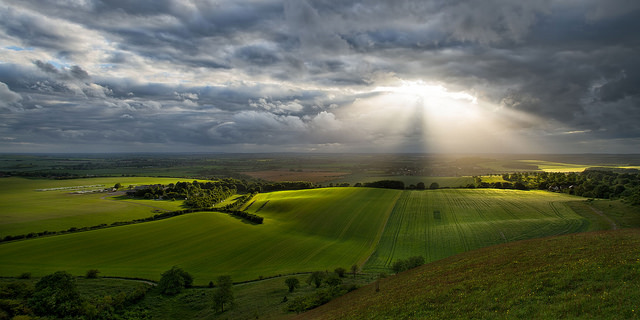This coming April 22, 2019, is the fiftieth year of celebrating Earth Day, which began on April 22, 1970. As such it’s the Jubilee Year of Earth Day. It is also the day after Easter.
There are two ways to look at this. In a congregation in which the call to ecological healing has yet to be heard, Earth Day will likely be smothered by Holy Week and Easter. It will be Low Monday.
But in a congregation where leaders and members realize our dependence on the creation we inhabit, and the crisis we are facing in this ecosystem, it makes sense that Earth Day should coincide with the beginning of the Easter season.
Think about it. During Lent, even though we know Easter will come this year because the first Easter came, we still reflect emotionally on the violence at work in the crucifixion story, the violence still at work in our stories. We experience ourselves in the crux between a society gone dangerously awry and the hope that we may yet save ourselves from the disaster of climate change. Easter Sunday offers comfort in the form of Christ’s resurrection, signaling the survival of what we thought was lost.
Earth Day is likewise part celebration and part urgency. Part thanksgiving for the blessing of creation with all its beauty and bounty, and part cry of compassion for what has been lost and prayer for what is endangered. On Earth Day, as through Lent and into Easter, we experience life hanging in the balance between violence and peace, evil and goodness, fear and hope.
How might a congregation bring Easter hope to Earth Day? By remembering throughout the upcoming weeks that we don’t live simply in a human world, but in the broader world of God’s creation. Prayers of penitence for human inaction can become vows to act. Petitions on behalf of those suffering ecological damage can be prayed in the light of Easter hope.
March 3, 2019: Transfiguration Sunday commends bold, transformative leadership:
- Exodus 34:29-35 describes Moses’ leaving Sinai with the commandments, his face shining.
- Psalm 99 announces God as ruler of all, lover of justice, establishing equity, answering prayers.
- 2 Corinthians 3:12-4:2 comments that “since we have such a great hope, we act with boldness … we do not lose heart.”
- Luke 9:28-36 narrates Jesus’ powerful transfiguration, which the disciples failed to understand.
March 10, 2019, First Sunday of Lent, emphasizes our utter dependence on God:
- Deuteronomy 26:1-11 prescribes bringing the first fruits before the priest while recounting a story characterized by gratitude, reminding hearers of the natural miracle of food.
- Psalm 91:1-2, 9-16 commends security in God alone.
- Romans 10:8b-13 recalls God’s love for all without distinction.
- Luke 4:1-13 shows Jesus’ practice of fasting and ability to withstand temptations.
March 17, Second Sunday of Lent, offers various other ecological opportunities:
- In Genesis 15:1-12, 17-18, God invites Abram to consider future generations.
- Psalm 27 offers the ecologically poignant line “I believe I will see the Lord’s goodness in the land of the living.”
- Philippians 3:17-4:1, with its distinction between minds set on earthly treasures and heavenly realities, invites reconsideration of what belonging to God means — renunciation not of God’s creation, but of materialism, which defies God.
- In Luke 13:31-35, Jesus compares his compassion to a mother hen’s care.
March 24, Third Sunday of Lent, once again emphasizes food:
- Isaiah 55:1-9 reminds us of a world where food and drink are not commodified, where all are freely invited to “come to the waters.” It commends wise choices, so that we may “eat what is good.”
- Psalm 63:1-8 uses the imagery of drought to describe longing for the rich feast of God’s presence.
- 1 Corinthians 10:1-13 shares the theme of food, remembering the story of manna in the wilderness and the water God gave from the rock.
- Luke 13:1-9 teaches that those who suffer are not necessarily those who sinned. God waits for us all to bear good fruit.
March 31, Fourth Sunday of Lent, reminds readers to seize the day by responding appropriately to God’s bounteous love:
- Joshua 5:9-12 relates the first day that the children of Israel eat food grown in the land of Canaan.
- Psalm 32 remembers the dangers of drought and flood, and reminds humans that God has taught us the way we should go.
- 2 Corinthians 5:16-21 reminds readers that God’s new creation begins now, in this world, where we might become “the righteousness of God.”
- Luke 15:1-3, 11b-32 narrates a father’s joy when his dissolute son stops squandering his heritage and returns home.
April 7, Fifth Sunday of Lent, emphasizes God’s gifts manifest often in mundane necessities like water and food:
- Isaiah 43:16-21 describes “a new thing” that God will do: rivers in the desert for the people that God formed “to declare my praise.”
- Psalm 126 remembers God’s restoration in the past and prays for restoration today, like “watercourses in the Negeb,” so that “those who go out weeping, bearing the seed for sowing, shall come home with shouts of joy, carrying their sheaves.”
- Philippians 3:4b-14 ponders Paul’s wish, willingly forfeiting his former status, to know the power of Christ’s resurrection.
- John 12:1-8 tells the story of Mary’s profuse anointing of Jesus, as profuse as the bounty with which God graces the earth.
April 14, Passion Sunday, commemorates the holiness of humility:
- Isaiah 50:4-9a expresses reliance on God in the face of human opposition.
- Psalm 31:9-16 could be the prayer not only of the lowly, but of the earth itself, distressed, ignored, “like a broken vessel,” yet praying for God’s favor.
- Philippians 2:5-11, resisting arrogance, looks toward the day when every tongue confesses the self-emptying Christ as Lord.
- Luke 22:14–23:56 begins with Jesus’ last supper, reminding us of God’s presence even in the ordinary gifts of food and drink. It ends with Jesus’ body laid in the earth.
April 21, Easter Sunday, is filled with imagery from the natural world:
- Acts 10:34-43 recounts Peter’s realizing for the first time that Jesus “is Lord of all” (verse 36). He emphasizes his growing awareness that the good news is good for everyone. For Peter, this post-resurrection discovery of mercy’s wideness is new.
- Isaiah 65:17-25 speaks of the earth’s restoration as a place where people joyfully live out their natural lives, planted and not uprooted: “for like the days of a tree shall the days of my people be, and my chosen shall long enjoy the work of their hands” (verse 22).
- Psalm 118:1-2, 14-24 uses elements of the natural world — stones and tree branches — to help describe rejoicing.
- 1 Corinthians 15:19-26 celebrates Christ as “first fruits of those who have died.”
- John 20:1-18 relates the disciples’ discovery of Jesus’ resurrection at the garden tomb. Given the creation stories’ attention to plants and planting, and God’s placing the first Adam to tend and keep the garden, Mary was more right than she may have known when she supposed Jesus to be the gardener. Creation comes full circle in God’s new creation.
- Luke 24:1-12 employs the mundane elements of spices and stones to surround the miracle of God’s transcending death.
April 28, Second Sunday of Easter, suffuses all of ordinary life with God’s grace:
- Acts 5:27-32: A newly valiant Peter defies authorities who try to keep him quiet.
- Psalm 118:14-29 reminds us that God’s steadfast love is forever. In particular, it remembers what is undervalued: “The stone that the builders rejected has become the chief cornerstone.”
- Psalm 150 (alternate), and the book of Psalms overall, concludes by celebrating all of life’s dependence on God: “Let everything that breathes praise the LORD!”
- Revelation 1:4-8: God is known as “the alpha and the omega.”
- John 20:19-31: Jesus both breathes the Holy Spirit on disciples and reminds them of the incarnational, fleshly nature of his presence.
Patricia Tull’s bimonthly Working Preacher column, “The Great Community,” focuses on ecological themes for preaching.

